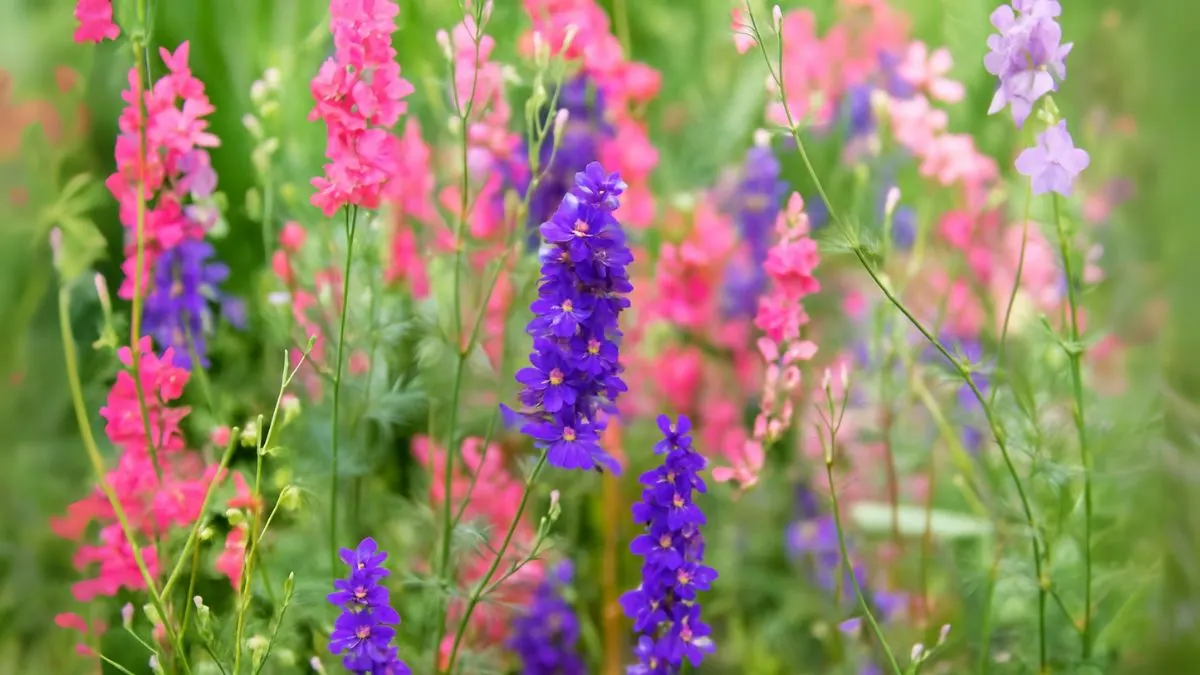Tall, elegant, and bursting with color, larkspur flowers are a must-have for anyone who wants a statement plant in their garden. Known for their delicate spires and pastel hues, larkspurs bring cottage-garden charm while being surprisingly easy to grow from seed.
When I first tried them in my backyard in Toronto, I underestimated how tall and dramatic they could get. With minimal care, they created a floral wall that looked straight out of a postcard. Let’s walk through everything you need to know about growing these beauties.
Why Choose Larkspur for Your Garden?

Larkspurs are prized for their:
- Striking spikes of blue, pink, and purple flowers.
- Long blooming season.
- Ability to attract pollinators like bees and butterflies.
- Easy adaptability when given the right soil and sunlight.
Gardeners across the USA and Canada love them for cut flower arrangements, too, since they hold up well in vases.
When and How to Sow Larkspur Seeds
- Timing Matters: You can grow larkspur from seed from February to June, or September to October, depending on your region. They thrive in cool temperatures and require full sun, so plan your sowing accordingly.
- Direct Sowing Outdoors: The simplest method is to sow larkspur seeds where you want the plants to grow in fall, or first thing in spring. Unlike some flowers, they don’t always transplant well, so it’s best to start them in their final growing spot.
- Rake the soil to create a fine top layer.
- Plant seeds directly into well-draining soil in a spot with full sun to partial shade, enriching it with compost.
- Sow the seeds in a prepared bed, covering them lightly with soil, and keep the soil moist.
If you enjoy a natural look, you can also try throwing the seeds out in the growing patch and letting them germinate where they fall.
Also Read: How Often Should You Water Begonias?
Choosing the Right Soil and Location
Larkspur performs best when you choose well-drained soil that is fertile but not soggy. Sandy or loamy soil types are ideal.
- Sunlight exposure: They do best in full sun to partial shade.
- Soil prep: Add compost before planting to enrich the soil.
- Moisture: Keep the soil evenly moist during germination but avoid waterlogging.
Step-by-Step Guide to Growing Larkspur
Step |
What to Do |
1 |
Choose well-drained soil and prepare the bed with compost. |
2 |
Sow larkspur seeds where you want the plants to grow in fall, or first thing in spring. |
3 |
Cover seeds lightly with soil and water gently. |
4 |
Maintain cool temperatures and require full sun for strong growth. |
5 |
Thin seedlings once they reach 3–4 inches to avoid crowding. |
Caring for Larkspur After Germination
Once your seedlings appear, care is fairly straightforward:
- Watering: Keep the soil moist but not soggy. Overwatering can lead to root rot.
- Sunlight: Ensure they get at least 6 hours of sun daily.
- Support: Taller varieties may need staking to prevent them from toppling over in the wind.
- Deadheading: Remove spent blooms to encourage continuous flowering.
Also Read: How to Grow Watermelons for Juicy, Sweet Harvests
My Personal Experience
The first year I grew larkspurs, I didn’t stake them, and a summer storm flattened half of my patch. The next year, I used bamboo sticks to support them, and the results were phenomenal. I also noticed that plant seeds directly into well-draining soil in a spot with full sun to partial shade, enriching it with compost made the flowers taller and more vibrant.
Common Problems and Solutions
Problem |
Solution |
Poor germination |
Cool temperatures and require full sun; refrigerate seeds for a week before planting to break dormancy. |
Plants falling over |
Stake tall plants or grow them in sheltered areas. |
Yellowing leaves |
Avoid waterlogged soil; always choose well-drained soil. |
Fungal diseases |
Water at the base, not overhead, to prevent mildew. |
Growing larkspur is easier than most gardeners think. If you’ve been dreaming of tall, colorful spires in your garden, now’s the time to try. Start small, experiment with throwing the seeds out in the growing patch, and soon, you’ll have a flower bed that stops visitors in their tracks.
👉 Ready to take your garden to the next level? Try larkspurs this season and experience the joy of growing one of the most breathtaking flowers for yourself.






